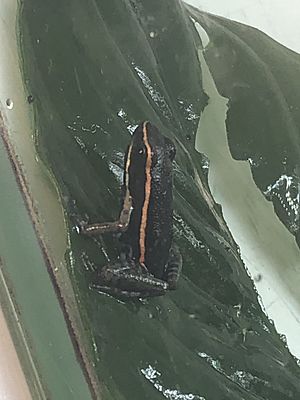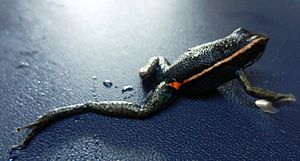Amarakaeri poison frog facts for kids
Quick facts for kids Amarakaeri poison frog |
|
|---|---|
 |
|
| Ameerega shihuemoy at the Manu Learning Centre | |
| Conservation status | |
| Scientific classification | |
| Genus: |
Ameerega
|
| Species: |
shihuemoy
|
The Amarakaeri poison frog (scientific name: Ameerega shihuemoy) is a type of dart frog. It lives only in a small area of southeastern Peru. You can find it in the Manú District, where the mountain rainforest meets the lowland rainforest. This frog is part of the Ameerega picta group.
Scientists first found this frog at the Manú Learning Centre. It lives in forests that have been partly logged. The Amarakaeri poison frog is currently endangered. Its home is shrinking because of agriculture (farming), gold mining, oil extraction, new roads, and logging (cutting down trees).
Right now, this frog is known from only nine places in the world. Three of these are in the Manú Biosphere Reserve, and six are in the Amarakaeri Communal Reserve. Because there are so few places where it lives, it is considered an endangered species.
Contents
What's in a Name? The Shihuemoy Story
The word shihuemoy comes from the Harakmbut language. It means "poison dart frog." The Harakmbut people are an indigenous group who live in southeastern Peru. They live in the same areas where this frog is found. This is why scientists chose a name that honors the local culture and language.
Where Do Amarakaeri Poison Frogs Live?
The Amarakaeri poison frog lives on the ground in the Andean foothills of the Manú District. They prefer areas with fast-flowing rocky streams and forests that haven't been disturbed much. These frogs are usually found in untouched rainforests or slightly regrowing forests. They like places near rocky, fast-moving streams.
You can find them at elevations between 340 and 850 meters (about 1,115 to 2,789 feet) above sea level. When there isn't much disturbance, they also live near wetlands. During the rainy season, they might be found near small, temporary pools of water.
Daily Life and Sounds
These frogs are most active during dusk and dawn. This means they are busy in the early morning and late afternoon. During these times, you can often hear the male frogs calling out.
Males usually call from rocks, leaf litter, or fallen branches. At night, they rest on low plants. They also use small cracks under roots, logs, and boulders to hide.
Family Life of the Frog
Female Amarakaeri poison frogs lay about 20 to 25 eggs. They place these eggs inside rock shelters close to streams. The male frog then protects the eggs until they hatch. After the eggs hatch, the male carries the tiny tadpoles on his back to the stream. One male frog was seen carrying 10 tadpoles this way!
Scientists believe these frogs reproduce all year round, in both the dry and rainy seasons. This is because their mating calls can be heard throughout the year. During the dry season, they stay close to rocky streams and boulders. In the rainy season, they move deeper into the rainforest.
Frog Neighbors
The tadpoles and young frogs of the Amarakaeri poison frog have been found living with tadpoles of another species, the Manú poison frog (Ameerega macero). Both types of tadpoles live in streams with shallow, slow-moving, clear water. These streams often have sand and dead leaves at the bottom.
As adults, Amarakaeri poison frogs share their habitat with other Ameerega species. At the Manú Learning Centre, they live alongside Ameerega macero and Ameerega hahneli. They might also live with Ameerega trivittata and Ameerega simulans in other parts of their range.
What Do Their Calls Sound Like?
The Amarakaeri poison frog has a special call that sounds different from other Ameerega frogs in the area. Their mating call is a series of short, chirping notes. These notes are repeated about one time per second. Each note lasts for a very short time, less than a second. The main sound frequency of their call is quite high. They usually call most loudly in the early morning (5:00-9:00 AM) and late afternoon (4:00-6:00 PM).
They also have a second type of call. This call has three quick notes, repeated every 4-5 seconds. The notes in this second call are slightly different lengths. This "secondary call" seems to be a way for the frogs to mark their territory. It might be used to challenge or warn other frogs.
What Does the Amarakaeri Poison Frog Look Like?
This frog is a medium-sized dart frog. Its back is black and has no markings. It has a bright orange stripe that runs from its nose to its upper leg. This stripe turns into a bright orange blotch on its thigh.
Under its eye, the frog has a whitish-bronze stripe. This stripe goes under its eardrum to the base of its upper arm. Its legs are brown with faint dark spots. The underside of the frog is a bright blue with a bold black net-like pattern. This blue color fades to a pale gray or bronze on the sides of the frog. The frog's eyes are black with small copper flecks. The eggs of this frog are covered in a clear orange jelly-like substance.
These frogs are usually between 19.2 and 25.7 millimeters (about 0.75 to 1.01 inches) long from snout to vent (the opening at the end of the body). Males are generally smaller, measuring about 19.2 to 21.8 mm (0.75-0.86 inches). Females are a bit larger, from 21.5 to 25.7 mm (0.84-1.01 inches).
Which Frogs Look Similar?
Several other Ameerega species look a lot like the Amarakaeri poison frog. However, you can tell them apart by their different colors.
- Ameerega hahneli and Ameerega picta are the most similar. But they are smaller, have white stripes on their backs, and yellow blotches on their lower legs.
- Ameerega boliviana has a yellow stripe on its back, a white stripe on its side, and a cream-colored belly with black patterns.
- Ameerega yungicola also looks similar. However, it has a white stripe on its side and a throat that doesn't have a marbled pattern.
See also
 In Spanish: Ranita venenosa de Amarakeri para niños
In Spanish: Ranita venenosa de Amarakeri para niños



